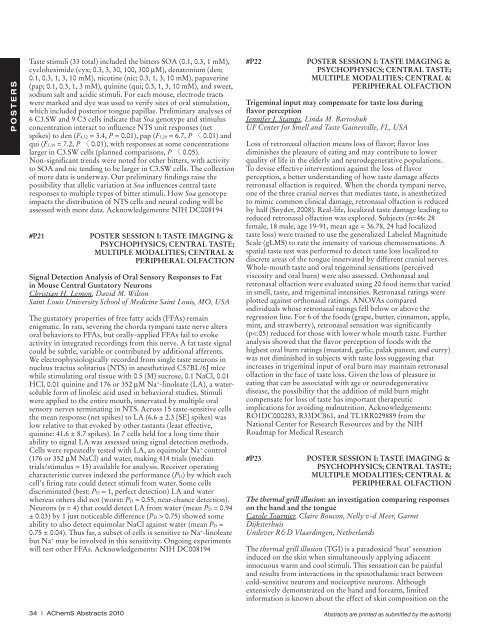Abstracts - Association for Chemoreception Sciences
Abstracts - Association for Chemoreception Sciences
Abstracts - Association for Chemoreception Sciences
Create successful ePaper yourself
Turn your PDF publications into a flip-book with our unique Google optimized e-Paper software.
P O S T E R S<br />
Taste stimuli (33 total) included the bitters SOA (0.1, 0.3, 1 mM),<br />
cycloheximide (cyx; 0.3, 3, 30, 100, 300 mM), denatonium (den;<br />
0.1, 0.3, 1, 3, 10 mM), nicotine (nic; 0.3, 1, 3, 10 mM), papaverine<br />
(pap; 0.1, 0.3, 1, 3 mM), quinine (qui; 0.3, 1, 3, 10 mM), and sweet,<br />
sodium salt and acidic stimuli. For each mouse, electrode tracts<br />
were marked and dye was used to verify sites of oral stimulation,<br />
which included posterior tongue papillae. Preliminary analyses of<br />
6 C3.SW and 9 C3 cells indicate that Soa genotype and stimulus<br />
concentration interact to influence NTS unit responses (net<br />
spikes) to den (F4,52 = 3.4, P = 0.01), pap (F3,39 = 6.7, P 〈 0.01) and<br />
qui (F3,39 = 7.2, P 〈 0.01), with responses at some concentrations<br />
larger in C3.SW cells (planned comparisons, P 〈 0.05).<br />
Non-significant trends were noted <strong>for</strong> other bitters, with activity<br />
to SOA and nic tending to be larger in C3.SW cells. The collection<br />
of more data is underway. Our preliminary findings raise the<br />
possibility that allelic variation at Soa influences central taste<br />
responses to multiple types of bitter stimuli. How Soa genotype<br />
impacts the distribution of NTS cells and neural coding will be<br />
assessed with more data. Acknowledgements: NIH DC008194<br />
#P21 POSTER SESSION I: TASTE IMAGING &<br />
PSYCHOPHYSICS; CENTRAL TASTE;<br />
MULTIPLE MODALITIES; CENTRAL &<br />
PERIPHERAL OLFACTION<br />
Signal Detection Analysis of Oral Sensory Responses to Fat<br />
in Mouse Central Gustatory Neurons<br />
Christian H. Lemon, David M. Wilson<br />
Saint Louis University School of Medicine Saint Louis, MO, USA<br />
The gustatory properties of free fatty acids (FFAs) remain<br />
enigmatic. In rats, severing the chorda tympani taste nerve alters<br />
oral behaviors to FFAs, but orally-applied FFAs fail to evoke<br />
activity in integrated recordings from this nerve. A fat taste signal<br />
could be subtle, variable or contributed by additional afferents.<br />
We electrophysiologically recorded from single taste neurons in<br />
nucleus tractus solitarius (NTS) in anesthetized C57BL/6J mice<br />
while stimulating oral tissue with 0.5 (M) sucrose, 0.1 NaCl, 0.01<br />
HCl, 0.01 quinine and 176 or 352 mM Na + -linoleate (LA), a watersoluble<br />
<strong>for</strong>m of linoleic acid used in behavioral studies. Stimuli<br />
were applied to the entire mouth, innervated by multiple oral<br />
sensory nerves terminating in NTS. Across 15 taste-sensitive cells<br />
the mean response (net spikes) to LA (6.6 ± 2.3 [SE] spikes) was<br />
low relative to that evoked by other tastants (least effective,<br />
quinine: 41.6 ± 8.7 spikes). In 7 cells held <strong>for</strong> a long time their<br />
ability to signal LA was assessed using signal detection methods.<br />
Cells were repeatedly tested with LA, an equimolar Na + control<br />
(176 or 352 mM NaCl) and water, making 414 trials (median<br />
trials/stimulus = 15) available <strong>for</strong> analysis. Receiver operating<br />
characteristic curves indexed the per<strong>for</strong>mance (PD) by which each<br />
cell’s firing rate could detect stimuli from water. Some cells<br />
discriminated (best: PD = 1, perfect detection) LA and water<br />
whereas others did not (worst: PD = 0.55, near-chance detection).<br />
Neurons (n = 4) that could detect LA from water (mean PD = 0.94<br />
± 0.03) by 1 just noticeable difference (PD > 0.75) showed some<br />
ability to also detect equimolar NaCl against water (mean PD =<br />
0.75 ± 0.04). Thus far, a subset of cells is sensitive to Na + -linoleate<br />
but Na + may be involved in this sensitivity. Ongoing experiments<br />
will test other FFAs. Acknowledgements: NIH DC008194<br />
#P22 POSTER SESSION I: TASTE IMAGING &<br />
PSYCHOPHYSICS; CENTRAL TASTE;<br />
MULTIPLE MODALITIES; CENTRAL &<br />
PERIPHERAL OLFACTION<br />
Trigeminal input may compensate <strong>for</strong> taste loss during<br />
flavor perception<br />
Jennifer J. Stamps, Linda M. Bartoshuk<br />
UF Center <strong>for</strong> Smell and Taste Gainesville, FL, USA<br />
Loss of retronasal olfaction means loss of flavor; flavor loss<br />
diminishes the pleasure of eating and may contribute to lower<br />
quality of life in the elderly and neurodegenerative populations.<br />
To devise effective interventions against the loss of flavor<br />
perception, a better understanding of how taste damage affects<br />
retronasal olfaction is required. When the chorda tympani nerve,<br />
one of the three cranial nerves that mediates taste, is anesthetized<br />
to mimic common clinical damage, retronasal olfaction is reduced<br />
by half (Snyder, 2008). Real-life, localized taste damage leading to<br />
reduced retronasal olfaction was explored. Subjects (n=46: 28<br />
female, 18 male, age 19-91, mean age = 36.78, 24 had localized<br />
taste loss) were trained to use the generalized Labeled Magnitude<br />
Scale (gLMS) to rate the intensity of various chemosensations. A<br />
spatial taste test was per<strong>for</strong>med to detect taste loss localized to<br />
discrete areas of the tongue innervated by different cranial nerves.<br />
Whole-mouth taste and oral trigeminal sensations (perceived<br />
viscosity and oral burn) were also assessed. Orthonasal and<br />
retronasal olfaction were evaluated using 20 food items that varied<br />
in smell, taste, and trigeminal intensities. Retronasal ratings were<br />
plotted against orthonasal ratings. ANOVAs compared<br />
individuals whose retronasal ratings fell below or above the<br />
regression line. For 6 of the foods (grape, butter, cinnamon, apple,<br />
mint, and strawberry), retronasal sensation was significantly<br />
(p
















